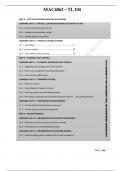Summary
Summary TL 104 Learning Unit 14.1-3 PRODUCT COSTING SYSTEMS
- Institution
- University Of South Africa (Unisa)
This document contains an extensive summary of Learning Unit 14 covered in Tutorial Letter 104 which is examinable for Test 3 on 13 June 2023. Topics covered include job costing, process costing and joint- and by-product costing. I used DRURY 10th edition for my summaries, and the chapters covered ...
[Show more]




